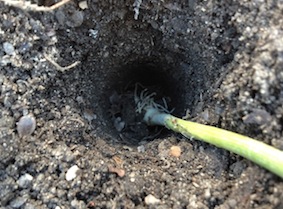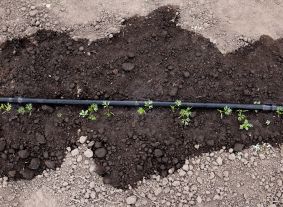Growing Leeks
Views: 3073

I generally like to mix up the topics I write about, and try hard to write about a diversity of vegetables and veggie gardening stuff. But excuse me if I repeat myself, at least somewhat. I’d like to revisit leeks.
The last time I wrote about leeks was in July 2011. I had planted about a dozen plants within a 1-ft. by 3-ft. by 6-in. frame. The frame was to hold in extra soil. As the plants grew tall, adding soil (or sand or extra mulch) around them limits their exposure to light, causing the skins to remain white instead of turning green.
Did that work? Yes, it did.
Did I have fabulous leeks? I had good leeks. I didn’t have great leeks, but I had good leeks.
Bear in mind, I’m gauging “great” on what you’d find in the Whole Foods produce department—the leeks that are as thick as a 10-year-old’s arm. Mine were good—maybe the thickness of a large piece of sidewalk chalk. And most importantly, they TASTED like leeks. Why were they good and not great? Likely it was a nutrition issue, as in I didn’t apply enough fertilizer.
This year’s leeks
I’m trying leeks again this year. This time I got some from my garden neighbor, who orders a bundle through mail order. He gave me maybe two dozen, all about the size of a golf pencil, so they are quite small.
Even though I planted them just last week, I already have one mark against me in this year’s leek crop. I did not add compost to my soil. Didn’t have any on hand at the time. I’m hoping the 6 inches of new loam added to the garden will have some nutrient charge in it, at least for the time being.
Pro tip for watering
My garden neighbor was present when I planted my leeks this year. He gave me a great piece of advice that he had learned from his father. To plant, dibble a hole 3-4 inches deep. Insert the small leek plant—it won’t stick up much beyond the rim of the hole, believe me, and that’s okay.
Next, turn on your hose with sprinkler attachment and GENTLY water them. This does two things: 1) water fills the hole, assuring your initial watering gets all the way down to the tip of the roots, and 2) the surrounding walls of the hole start to collapse, filling the hole with mud. This ensures that at least the first 3-4 inches of your growing leek will become “bleached,” or rather, it’ll remain white.
Yes, you can still add soil to your leek bed to block light and keep your skins white as they grow taller. But it’s nice to know you at least have a head start.
Stay tuned for progress reports.
Meet Ellen Wells
When you’re raised on a farm, you can’t help but know a thing or two about gardening. Ellen Wells is our expert on edible gardening.…
Ellen's Recent Posts

Asparagus






